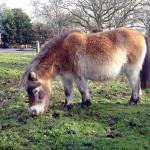Ancient cave paintings, fact or fiction? Prehistoric Horse DNA Holds the Key
Before the dawn of the written language, prehistoric humans began recording events from their daily lives and environment on the walls of their local caves. Now many of these cave paintings are treasured, priceless works of ancient history and art. Many different animals are represented in these paintings and about a third of them are horses. [1]
There has been much speculation about exactly which horse breeds existed when the painting of cave walls began about 25,000 years ago. Some of the types predicted included bays, grays and horses with dun colored coats with pangaré markings (tan coat with white around the muzzle, belly and eyes-pictured above).
Discovered in the Peche-Merle caves in the Midi-Pyrénées region of France, was an illustration of a “horse of a different color”, white with black spots. Some archaeologists doubted the accuracy of the painting, believing that this spotted variety post-dated the period in which the paintings were created. They supposed that ancient cave art might be more symbolic than realistic. A DNA analysis conducted on nearly 90 ancient horses dating from 12,000 to 1,000 years ago seemed to support this theory. Out of the 90 samples, there were many examples of bay and black breeds, but no evidence of the spotted variety. [1]
The team decided to expand their analysis by selecting 31 pre-domestic horse samples (involving bones and teeth), dating back as far as 35,000 years ago from Siberia, Eastern and Western Europe and the Iberian Peninsula.[2] The results of the analysis revealed 18 bays (reddish to reddish brown), 7 horses with black coats, and, surprisingly, 6 samples had the genetic marker for spots, also known as “LP” for leopard-like spotting. This was the first evidence for the white spotted phenotypes in pre-domestic horses, and therefore suggested that our ancestors were accurately depicting their life and times, not formulating fantasy. [2]
So, this begs the question, why would spotted horses be more abundant 14,000 or more years ago only to thin their numbers after? The answer was most likely “Darwinian,” and based on natural selection. During the Ice Age, white spotted horses would have the advantage of better camouflage in snow conditions, leaving them less visible to predators. However, the genetics behind the gene had a disadvantage. In modern horses, if two copies of the “LP” gene are inherited (one from Mom, one from Dad), these horses have “night blindness”. This handicap would leave spotted horses susceptible to any nocturnal predators hungry for a big meal. As the Ice receded, it is believable that the spotted horses would appear less in the gene pool and may have disappeared entirely if not for humans. After humans began to domesticate horses, breeding them for aesthetic value became common. The rare spotted horses were likely bred for their visual appeal.
Citations:
- http://www.wired.com/wiredscience/2011/11/cave-painting-colors/: Cave Paintings Showed True Colors of Stone Age Horses
- http://www.biologynews.net/archives/2011/11/07/ancient_dna_provides_new_insights_into_cave_paintings_of_horses.html: Ancient DNA Provides New Insights into Cave Paintings of Horses
| Print article | This entry was posted by Elna Carrasco on November 29, 2011 at 12:08 pm, and is filed under DNA Interactive. Follow any responses to this post through RSS 2.0. You can leave a response or trackback from your own site. |


